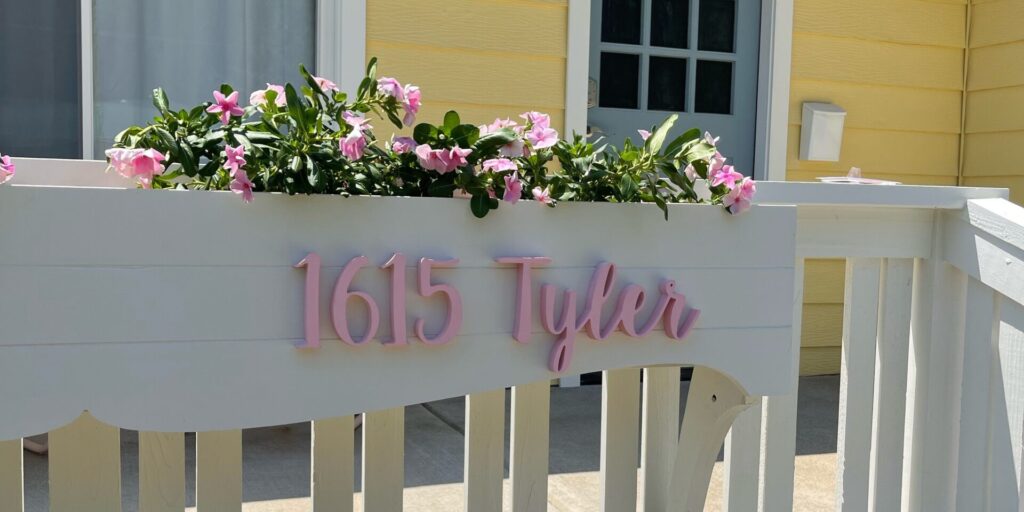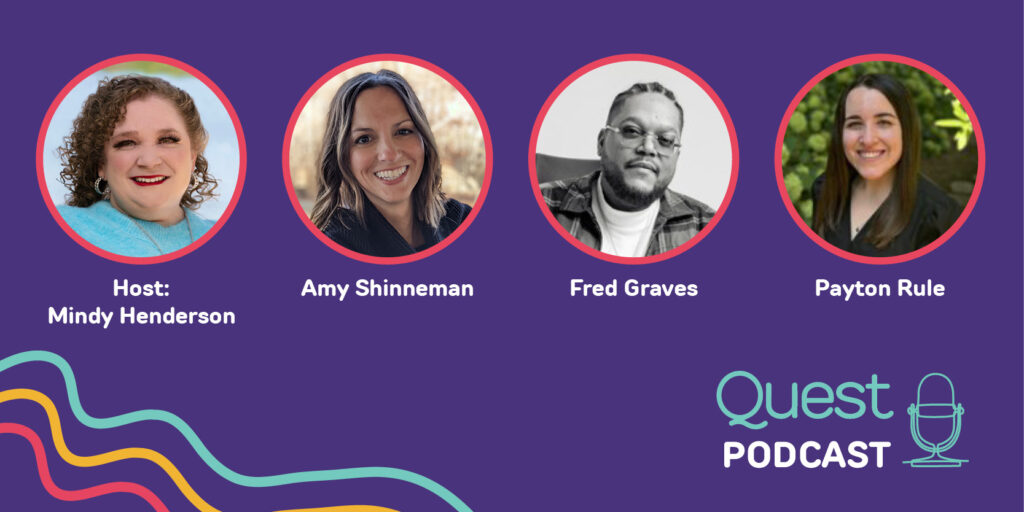
A Guide to Getting Involved in Adaptive Sports
By Charmaine Dymond | Friday, May 10, 2024
5 Second Summary
There is an adaptive sport for every ability. Read on to hear what people in the neuromuscular disease community love about sports and learn how to find programs and equipment.
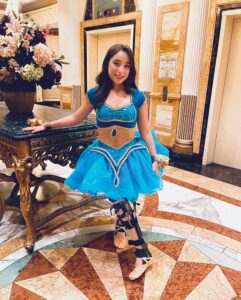
Leah poses in costume for a dance performance.
Leah Zelaya, 16, an MDA National Ambassador, is a dancer and athlete. When she was 6, she started taking classes with Dancing Dreams, an organization that offers adaptive dance for children with disabilities in the New York area. In her younger years, a teenage helper acted as her spotter as she practiced. Now, she dances using bilateral leg braces or a wheelchair equipped with special features for dance.
“I was brought up playing sports my whole life,” says Leah, who also skis, hand cycles, and plays pickleball. “My father always inspired me with his passion for sports and how determined he is when he does them.”
Leah and her father, Jaime, both live with scapuloperoneal spinal muscular atrophy (SPSMA). Though they share the same disease, Jaime is quick to point out that they don’t share a love for all the same sports. “The sports I like she doesn’t like, and the sports she likes, I won’t even dare to play,” he says. “I’m holding

Jaime has a wheelchair customized for sports like tennis.
my heart and trying not to die of a heart attack when I see her coming down a mountain going almost 25 miles per hour.”
His admiration for his daughter is evident. While she credits him for inspiring her love of sports, he credits her with showing him that he could keep playing the sports he loves even after running and then walking became challenging. Leah and her mother, Bevi, connected Jaime to the Wheelchair Sports Federation, a national nonprofit that provides adaptive sports opportunities for youth and adults. Now he plays wheelchair basketball, softball, rugby, and tennis.
“I’d never played before in a wheelchair, but I got hooked,” says Jaime. “It’s given me a fountain of youth in my heart and my soul.”
A sport for every ability
Almost every sport can be modified to be adaptive, enabling people with disabilities to participate at a recreational or competitive level. Modifications include specially designed equipment, such as maneuverable wheelchairs for basketball or lighter shot-puts for track and field.
To ski, Leah sits in a bi-ski, similar to a sled on two skis. A sport might also be adapted through changes to the rules or field of play. For example, sitting volleyball uses a low net, and players sit on the floor, while power soccer is played in a gymnasium with players in power wheelchairs equipped with foot guards they use to pass and shoot a soccer ball.
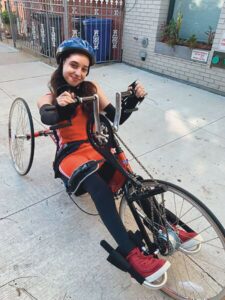
Leah Zelaya enjoys hand cycling.
Competitive adaptive sports programs use classification systems that group athletes based on their physical abilities and challenges. “Adaptive sports are an attempt at fairness,” says Clayton Frech, founder and CEO of Angel City Sports, a Los Angeles-based nonprofit providing adaptive sports for people of all ages with physical disabilities.
“When my son, Ezra, was younger, he would measure himself against boys his age in the track-and-field event he was doing with his disability, which is an above-knee amputation. So, he might run next to a kid with a below-knee amputation, but their times would not be compared,” Clayton says. “This keeps young kids engaged in sport, and some may end up competing nationally or even internationally.” Ezra is now on the US Paralympics team and is the world champion in his high jump classification.
Benefits of sports
For people with neuromuscular diseases, participating in adaptive sports offers a range of physical, emotional, and social benefits, such as improving strength, cardiovascular health, self-esteem, healthy habits, and social connections.
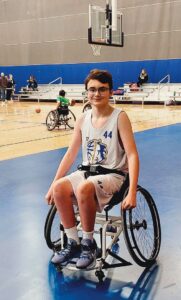
Brayden Tiernan plays wheelchair basketball.
“With adaptive sports, like any sport, you learn about teamwork, testing your boundaries, and putting yourself in uncomfortable positions and realizing you can do things you didn’t think you could — and that translates over into the rest of your life,” says Glenn Merry, Executive Director at Move United, a network of more than 225 organizations offering adaptive sports across the United States.
That’s been 16-year-old Brayden Tiernan’s experience. Brayden, who lives with Charcot-Marie-Tooth disease (CMT) and competes in wheelchair basketball and track and field, says that playing adaptive sports has taught him to be more independent and willing to try new things. Along with the physical benefits of sport, he’s gained practical skills, like wheelchair maintenance, and is mentoring younger athletes.
“My favorite part about adaptive sports is you’re not just learning how to play a sport, you’re also learning how to live life with disabilities,” he says.
Brayden’s parents have seen his confidence grow, and they are grateful for the friendships that have flourished. “We get to see him play sports, and we love the camaraderie he has with his teammates,” says Brayden’s father, Patrick. “And then we get to share our experiences with the other parents and give each other tips.”
Their school district in Louisville, Kentucky, has helped make this possible. “They started a whole adaptive program and are working on trying to get more events,” says Brayden, who plays on his high school wheelchair basketball team and in a competitive league with the Louisville Junior Mustangs.
Overcoming obstacles
Despite the growth of adaptive sports through organizations such as Move United and in schools, a lack of local opportunities in some areas remains an obstacle. Athletes might need to travel considerable distances for adaptive programs, which is time-consuming and expensive, putting these activities out of reach for many.
League play often requires traveling for games and tournaments. Thankfully for Brayden, the Junior Mustangs cover hotel and gas expenses, but his track-and-field program does not cover these costs.
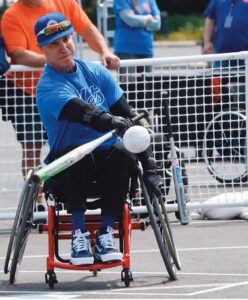
Jaime Zelaya, Leah’s father, plays wheelchair softball.
Getting equipment can be another obstacle for adaptive athletes. For example, some wheelchair sports require specially designed wheelchairs, which may need to be customized with seatbelts and cushions. Then there are the added costs of maintaining and repairing equipment. “It can build up pretty quickly,” says Patrick. “I don’t know where we would be if it weren’t for people and organizations donating their time and money.”
A dose of creativity and resourcefulness is helpful when looking for ways around these barriers. Organizations such as Challenged Athletes Foundation and Move United offer grants to offset some of the burden, while others, such as Angel City Sports, loan equipment to athletes.
Brayden recently applied for a grant through Challenged Athletes Foundation to replace the basketball wheelchair he outgrew. He also used crowdfunding to purchase a used racing chair so he could compete at regional and national track competitions.
Jaime has been the grateful recipient of donated sports wheelchairs. “That’s how it is in the disability community; we get a new chair, and we donate the other one,” he says.
Get moving
Leah’s biggest piece of advice for people considering playing an adaptive sport — especially if they’re feeling nervous about the idea — is to check it out in person.
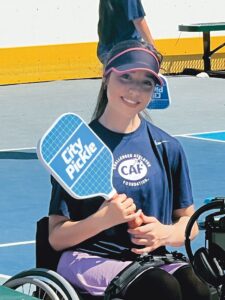
Leah recently discovered wheelchair pickleball.
“Seeing people with different conditions doing all these sports is truly what continues to motivate me,” she says. “When you see other people with different types of disabilities continue to do what they love, it’s such a special thing.”
Angel City Sports offers events in Southern California throughout the year where new and experienced athletes from around the country come together for adaptive sports clinics, recreational programs, and competitive sports. Their flagship event, the Angel City Games, is held in Los Angeles each summer. “It’s really good for people who want to learn and be exposed to sports because we offer 15 to 20 different sports, and it’s a very welcoming environment for new athletes,” Clayton says.
Brayden, who admits he didn’t think he’d like wheelchair basketball when he first tried it, encourages people to give adaptive sports a chance and to be open-minded about what activity might be a good fit for them. “I’m not going to be able to do wheelchair basketball or wheelchair track forever because my disability progresses in all four limbs. But as my disability progresses, I can do power soccer and other sports that are still really fun,” he says.
Charmaine Dymond is a freelance writer in Halifax, Canada.
Adaptive Sports Resource Guide
National Adaptive Sports Organizations
- Challenged Athletes Foundation
- Move United
- American Association of Adapted Sports Programs
- Achilles International
- US Paralympic Sport Development
- Wheelchair Sports Federation
Adaptive Sports Programs and Leagues
- Adaptive Track & Field USA
- National Wheelchair Basketball Association
- USA Climbing — Paraclimbing
- USA Hand Bike Circuit
- USA Hockey — Sled Hockey
- US Electric Wheelchair Hockey Association
- US Power Soccer Association
- US Wheelchair Rugby Association
Directories of State and Local Adaptive Sports Programs and Resources
- org/adaptive-sport-organizations
- net/resources-for-adaptive-athletes
- org/contact/athlete-resources
- org/grants-and-equipment
Grants for Equipment, Programs, or Travel
- Athletes Helping Athletes
- Challenged Athletes Foundation
- GoHawkeye Foundation
- IM ABLE Foundation
- Move United
- Semper Fi & America’s Fund
- Wheels for Wheels
Adaptive Sports and Disabled Athletes in the Media
Watch
- 2024 Paralympic Games on NBC
- “Murderball” (documentary) on Prime Video
- “Stumped” (documentary) on Vimeo
- “The Ataxian” (documentary) on YouTube
Read
- “4 Lessons I Learned from Adaptive Sports,” by Chad Wilson (Quest Magazine online)
- “Letters from Leah: The Importance of Physical Activity,” by Leah Zelaya (Quest Blog)
- “Limitless,” by Mallory Weggemann with Tiffany Yecke Brooks (biography)
- Move United Magazine
- “Tenacious,” by Patty Cisneros Prevo (children’s book)
Listen
Next Steps and Useful Resources
- Watch MDA’s Adaptive Recreation Facebook Live on-demand.
- For kids with neuromuscular diseases, MDA Summer Camp offers an opportunity to try new sports and activities in a safe and empowering environment.
- Learn about more ways to stay active with accessible outdoor recreation.
- Stay up-to-date on Quest content! Subscribe to Quest Magazine and Newsletter.
TAGS: Ambassadors, Equipment and Assistive Devices, Featured Content, Leah, Resources, Staying Active, Young Adults
TYPE: Featured Article
Disclaimer: No content on this site should ever be used as a substitute for direct medical advice from your doctor or other qualified clinician.


